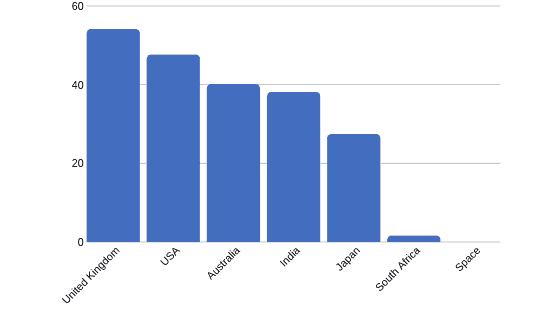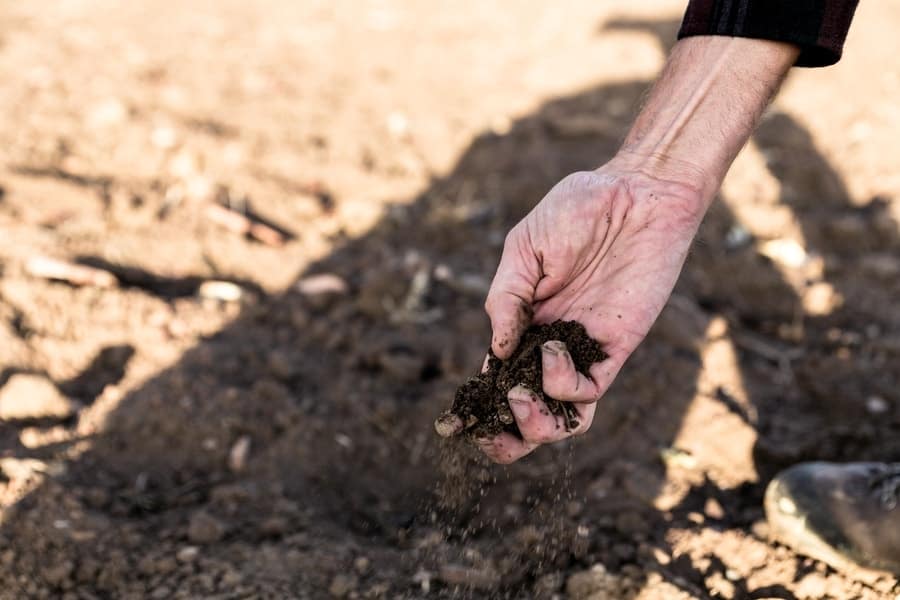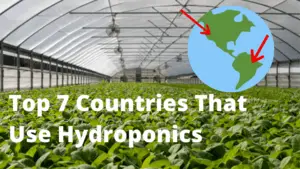When I was first learning about hydroponics, my curiosity has been piqued to know what actual countries had used hydroponics. I was super excited to know how scalable hydroponics had become and how it affected the way people grow things in different countries.
However, I couldn’t find any information online, so I have decided to do my research and discover where is hydroponics used nowadays.
So what are the countries that use hydroponics?
- Japan
- United States Of America
- India
- Space
- South Africa
- Australia
- United Kingdom
What Is The Production Size Of Each Country?
I have calculated the production size based on the production numbers of each commercial hydroponic farm present in every country.
I gathered this data from several resources that are available online such as news websites and well-known blogs in the hydroponics industry.

There are some commercial farms that I didn’t find actual data about. Therefore, I did not include them in the list.
I forgot to mention that these numbers also don’t include the production size of hobbyists and local growers as the government does not even gather these data, so it will be impossible for me to get these numbers right.
Below is a list of the production size of each country:
| The United Kingdom | 54 Million Pounds |
| The United States Of America | 47.5 Million Pounds |
| Australia | 40 Million Pounds |
| India | 38 Million Pounds |
| Japan | 27.3 Million Pounds |
| South Africa | 1.5 Million Pounds |
| Space | Unknown Data |

The United Kingdom
The United Kingdom’s production size is consists of the following:
- Thanet Earth: 53 million pounds/year
- Jones Food Company: 1 million pounds/year
The united kingdom has been facing many weather challenges in the past few years. During the summer season, heatwaves hugely impact the crops. It affects the crops directly by merely limiting the plant’s growth and on the other hand, indirectly by causing several lakes to drought, which means there is less water reaching the crop.
Extreme cold weather in winter also has a tremendous negative effect. Most of the plants have an optimum temperature between 50 and 65 degrees Fahrenheit which is pretty high compared to average temperatures that sometimes reach freezing temperatures in winter.

Vegetables like carrots and onions have skyrocketed by an 80% and 41% increase in the whole price, respectively. Moreover, the extreme weather conditions have impacted the livestock food supply, which means there is also an increase in meat prices.
After the significant effects of weather on the prices of vegetables and meat, there is an upgoing trend in the greenhouse methods of agriculture.
Greenhouses provide a more controlled environment for plants, which means that they will stay in their optimum conditions all the year unimpacted by the continuous weather changes.
Of course, the operational costs of greenhouses are uncomparably higher than that of traditional farming methods, but thanks to the continuous LED revolution, expenses are going down dramatically.
I have found some people who have gone the extra mile and tried to face the current extreme weather conditions.
Dring and Ballard’s Farms
Dring and Ballard are among those people. They have established a 5,400 square feet underground farm that is located below Clapham by 33 meters. They claim that their model can be expanded in different places like car parks, warehouses, and even abandoned tunnels from World War II.

Can you imagine how wonderful this is? I don’t think any of the World War II generals could predict that their tunnels could be ever used for anything other than war. Now they are being used to change the methods of how people grow food.
Thanet Earth
Another giant farm that is currently doubling down on hydroponics is Thanet Earth. It has over 55 hectares of greenhouse facilities in kent. Can you imagine how big their facilities are? They are equivalent to 55 large soccer fields lying side by side.
Their current production size is :
- Tomatoes: 30 million pounds/year
- Peppers: 14 million pounds/year
- cucumber: 9 million pounds/year
They have reached a point where all of their feeding and lightning schedules are automated using advanced technologies. To supply power for these facilities, they have built a power plant that is big enough to sell electricity to the national grid.

The United States Of America
The production size of the USA consists of the following:
- Aerofarms: 20 million pounds
- Green Spirit Farms: 13.5 million pounds
- Gotham Greens: 7.5 million pounds
- Plenty: 4.5 million pounds
- Bright Farms: 2 million pounds
I think that with all of these big numbers, I am still underestimating the USA by millions of pounds produced each year, and let me tell you why.
America has the highest number of hydroponic hobbyists and growers globally. Go to any forum that is known in the hydroponics niche; I bet you there will be at least 6 out of every 10 people asking or answering questions are living in the USA.
Not to mention, hydroponic equipment suppliers and manufacturers consider the USA to be their biggest market due to the high number of potential customers.
The USA also has set its self apart from other countries due to its extremely robust economy. Their economy allowed the spread of venture capitalists who are looking to make more profits every day by investing in startups.

The startups in the agricultural industry have been receiving more attention lately from investors due to their ability to change the future of how human grows food.
Some startups offer advanced solutions for growers like monitoring devices, others stick to growing plants hydroponically, and it seems to be working fine.
Aerofarms
Aerofarms is a case of a successful startup that has received a tremendous amount of funds from investors. It was founded in 2004 and didn’t receive any funds until late 2010; after that, it became unstoppable.
Today, this farm produces more than 20 million pounds of vegetables every year. Its facilities have a total space of over 100,000 square feet, which is fantastic. Moreover, they are trying to bring electricity costs down by doing various researches about different light systems in their 5,500 square feet research facility.
Plenty
Another farm that I think is currently gaining traction is Plenty. This startup has raised over 200 million dollars from elite investors, such as Soft bank, and is presently valued at 500 million dollars.
Plenty has set its 55,000 square feet facility in San Francisco and is currently trying to create new methods to scale crops like strawberries and cucumbers.
Australia
Australia’s production of hydroponic crops is made by 2 major players:
- Sundrop Farms: 30 million pounds
- Nectar Farms: 10 million pounds
This country is one of the most significant crop producers worldwide. Agriculture alone accounts for more than 12% of the Australian GDP, and there are currently over 300,000 employees working in this sector.
Unfortunately, Australia’s position as one of the biggest agricultural hubs is being threatened. Due to the extreme heatwaves that have been passing in the last few years, their water sources are now endangered. Last year, over 11% of Australia’s wheat production was impacted due to several nationwide droughts.

So, they are trying to shift gradually to hydroponics as it uses up 95% less water than traditional soil methods.
Sundrop Farms
Sundrop is a company that was founded in 2016 with a goal to grow higher yields with much less water required. This farm has cost over 200 million dollars to establish.
The high startup price comes from the huge desalination facility that they have made. This facility will use 23,000 tracking mirrors to purify salt water into irrigation water.
India
Their main production is done by the following:
- Junga Freshgreen: 40 million pounds
Generally speaking, countries don’t consider hydroponics as a method of growing until there is a water crisis, and this is the case for India.
The country is currently facing huge water scarcity problems, which are caused by several factors. It was first triggered by the poor governmental planning that had lead to an increase in untreated sewage and pollution to the already existing water sources.
On the other hand, population growth has increased significantly. In 2024, India is expected to be the world’s most populous country. The increased population has two significant effects on the water.
On one side, there will be a boom in the water demand required for more household use and agricultural activities. On the other hand, the high population will cause an increase in untreated sewage, which will further pollute the clean water sources available.
Moreover, there is a general rule in economics, which proves that a high population is not healthy for the economy of any country. I think this rule applies to India’s current situation. As the population increase, the demand for more food will increase, which means that food prices will have a considerable boost.
Most villages have taken steps in establishing their own hydroponic farms using recycled plastics to counter the increasing food prices and water insecurity.
Junga FreshnGreen
This is considered the most significant commercial farm in India. Junga Freshngreen is a 9.3-hectare facility that grows vegetables using hydroponics.
Their goal is to rely entirely on hydroponics and not depend on soil or water sources like in traditional farming methods. Furthermore, they are trying to prove that hydroponics can be easily scalable for commercial use, especially in India.
Chennai Man
Other people have been trying to make hydroponic facilities on a small scale. A man from Chennai has successfully created his hydroponic farm, which produces 6,000 plants annually. Not too big for commercial farms, but I consider it a good start for anyone trying to grow food with a new method like hydroponics.
Not only that, he has discovered a massive need for hydroponic systems by newbie farmers. So, he started to sell simple hydroponic growing kits. At first, he began with small 8 planter systems; then, he upgrades them to 24 and up to 1000 planter systems.
Japan
Japan has 3 main commercial farms which are:
- SPREAD: 19 million pounds
- Innovatus: 4.5 million pounds
- Mirai Co.: 3.8 million pounds
Most of Japan’s production comes from commercial farms. Unlike the USA, japan doesn’t have a lot of hydroponic growers among its population.
Hydroponics was first introduced to Japan after world war II by the US army. The massive adaption to hydroponics at the beginning came from the fact that most farms faced crop failures because of the microorganisms in the soil, and NFT hydroponic systems seemed to be a perfect solution for their problem.
They use styrofoam sheets to hold hydroponic cups. The sheets are placed at one end floating on the surface of a nutrient solution and slowly moves to the other side of the facility where they will be harvested. During their trip to the other side, they are exposed to lights with different wavelengths, which allow them to grow.
Daiei Supermarket
In 2002, Daiei supermarket tried to place computer-run NFT systems in their stores. This idea was initially copied from Denmark, and they thought they could give it a try. Due to the implementation of the computer in the system, it required only 4 technicians to run the whole system and produce fresh vegetables every day.
But this system had its flaws. For example, they couldn’t grow any crop other than lettuce. Moreover, the system had very high maintenance costs and electricity expenses that made it difficult to be profitable. So, they decided to discontinue the operations to cut losses.
Of course, the system would be profitable right now due to the significantly decreased electricity expenses. But we have to remember that Daiei’s trial was still back then in 2002. Currently, some companies invent their technologies to lower the costs as much as possible.
SPREAD
For many years, hydroponics was unprofitable due to well-known reasons that have led several companies to file for bankruptcy. SPREAD is an example of a company that made its technologies, which allowed them to survive and become profitable in the hydroponics industry.
They have invented special LED lamps that are more tailored to hydroponics, and at the same time, use less electricity. Furthermore, they are increasingly implementing automation machines and artificial intelligence in their hydroponic farms to reduce operational costs and increase production.
They are currently producing 30,000 lettuce heads per day and are planning to produce more with their current expansions.SPREAD is selling its crops at only a 30% higher price than other competitors. The higher price can be justified with the right marketing techniques about the product being pesticide-free and marketing it as a premium product.
South Africa
South Africa has a major producer:
- Charlie Malan: 1.55 million pounds/year
This farm is the largest hydroponic farm(40 hectares) in South Africa that I found records for online. The reason I believe that South Africa produces more than just 1.55 million pounds is that they are currently facing a water scarcity crisis.
Due to the water scarcity problem, hotels remove sink plugs to prevent tourists from filling the bathtubs. Moreover, warm water is restricted in some cases to make their residents finish their shower faster than usual. If this is happening in the tourism industry, can you imagine how it would be like for the agriculture industry right now?
More farms are trying to adapt to this crisis by converting to hydroponic systems. Of course, it will cost them a lot of money in initial costs, but it will be more sustainable and profitable in the future if the current situation didn’t change.
The Moon
This place mainly is not a country, but hopefully, it will be someday with the revolutionizing of the space exploration process.
When I first knew about this, I thought, why NASA would bother with growing vegetables on the moon when they can send them easily on their rockets? I was wrong.
Transporting vegetables to space is a big hassle. Aspects like the space they take and their actual weight are their most significant limitations. The space that this vegetable take could be used for transporting more critical equipment.
Moreover, several astronauts have complained about the bad taste of the vegetables transported from the earth due to the storing conditions that they must be kept in.
SpaceX has made an attempt on Nov 28, 2018, by launching a greenhouse to spin into orbit. This will help mimic the gravity of Mars and the Moon.



Awesome post! Keep up the great work! 🙂
what is ur middle and last name (it’s for school)
My full name is Youssef Mohamed Kholeif. Joe is my nickname.
GOOD JOB IN DOING BEAUTIFULLY THE RESEARCH AND PROVIDING ALL THE RELEVANT INFORMATION
This post is really interesting and full of information, I particularly found the part about them using hydroponic farms in space. Amazing!